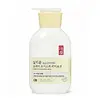What's inside
What's inside
 Key Ingredients
Key Ingredients

 Benefits
Benefits

 Concerns
Concerns

 Ingredients Side-by-side
Ingredients Side-by-side

Water
Skin ConditioningSodium C14-16 Olefin Sulfonate
CleansingGlycerin
HumectantCocamidopropyl Betaine
CleansingPEG-40 Hydrogenated Castor Oil
EmulsifyingSodium Chloride
MaskingSodium Methyl Cocoyl Taurate
CleansingPEG-150 Pentaerythrityl Tetrastearate
EmulsifyingParfum
MaskingAcrylates Copolymer
Simmondsia Chinensis Seed Oil
EmollientRosa Canina Fruit Oil
EmollientLactobacillus Ferment
Skin ConditioningSodium Hyaluronate
HumectantPEG-6 Caprylic/Capric Glycerides
EmulsifyingCocamide Mipa
EmulsifyingPolysorbate 20
EmulsifyingPolyquaternium-7
Disodium EDTA
Tocopherol
AntioxidantHydroxyacetophenone
AntioxidantSodium Hydroxide
BufferingBenzophenone-4
UV AbsorberIsopropyl Alcohol
SolventPropylene Glycol
HumectantSodium Benzoate
MaskingPhenoxyethanol
PreservativeEthylhexylglycerin
Skin ConditioningBenzyl Salicylate
PerfumingCoumarin
PerfumingHydroxycitronellal
PerfumingLimonene
PerfumingLinalool
PerfumingCI 60730
Cosmetic ColorantWater, Sodium C14-16 Olefin Sulfonate, Glycerin, Cocamidopropyl Betaine, PEG-40 Hydrogenated Castor Oil, Sodium Chloride, Sodium Methyl Cocoyl Taurate, PEG-150 Pentaerythrityl Tetrastearate, Parfum, Acrylates Copolymer, Simmondsia Chinensis Seed Oil, Rosa Canina Fruit Oil, Lactobacillus Ferment, Sodium Hyaluronate, PEG-6 Caprylic/Capric Glycerides, Cocamide Mipa, Polysorbate 20, Polyquaternium-7, Disodium EDTA, Tocopherol, Hydroxyacetophenone, Sodium Hydroxide, Benzophenone-4, Isopropyl Alcohol, Propylene Glycol, Sodium Benzoate, Phenoxyethanol, Ethylhexylglycerin, Benzyl Salicylate, Coumarin, Hydroxycitronellal, Limonene, Linalool, CI 60730
Water
Skin ConditioningButylene Glycol
HumectantAlcohol Denat.
AntimicrobialGlycerin
HumectantDimethicone
EmollientNiacinamide
SmoothingSqualane
EmollientCyclopentasiloxane
EmollientCamellia Oleifera Leaf Extract
AstringentCitrus Limon Peel Oil
MaskingCitrus Limon Fruit Extract
MaskingPanax Ginseng Root Extract
EmollientGardenia Taitensis Callus Extract
AntioxidantTheobroma Cacao Extract
Skin ConditioningGlyceryl Stearate
EmollientDimethiconol
EmollientBehenyl Alcohol
EmollientBis-PEG-18 Methyl Ether Dimethyl Silane
EmollientCetyl Ethylhexanoate
EmollientArachidyl Glucoside
EmulsifyingArachidyl Alcohol
EmollientCarbomer
Emulsion StabilisingTromethamine
BufferingPEG-100 Stearate
Dextrin
AbsorbentDisodium EDTA
Phenoxyethanol
PreservativeParfum
MaskingWater, Butylene Glycol, Alcohol Denat., Glycerin, Dimethicone, Niacinamide, Squalane, Cyclopentasiloxane, Camellia Oleifera Leaf Extract, Citrus Limon Peel Oil, Citrus Limon Fruit Extract, Panax Ginseng Root Extract, Gardenia Taitensis Callus Extract, Theobroma Cacao Extract, Glyceryl Stearate, Dimethiconol, Behenyl Alcohol, Bis-PEG-18 Methyl Ether Dimethyl Silane, Cetyl Ethylhexanoate, Arachidyl Glucoside, Arachidyl Alcohol, Carbomer, Tromethamine, PEG-100 Stearate, Dextrin, Disodium EDTA, Phenoxyethanol, Parfum
 Reviews
Reviews

Ingredients Explained
These ingredients are found in both products.
Ingredients higher up in an ingredient list are typically present in a larger amount.
Disodium EDTA plays a role in making products more stable by aiding other preservatives.
It is a chelating agent, meaning it neutralizes metal ions that may be found in a product.
Disodium EDTA is a salt of edetic acid and is found to be safe in cosmetic ingredients.
Learn more about Disodium EDTAGlycerin is already naturally found in your skin. It helps moisturize and protect your skin.
A study from 2016 found glycerin to be more effective as a humectant than AHAs and hyaluronic acid.
As a humectant, it helps the skin stay hydrated by pulling moisture to your skin. The low molecular weight of glycerin allows it to pull moisture into the deeper layers of your skin.
Hydrated skin improves your skin barrier; Your skin barrier helps protect against irritants and bacteria.
Glycerin has also been found to have antimicrobial and antiviral properties. Due to these properties, glycerin is often used in wound and burn treatments.
In cosmetics, glycerin is usually derived from plants such as soybean or palm. However, it can also be sourced from animals, such as tallow or animal fat.
This ingredient is organic, colorless, odorless, and non-toxic.
Glycerin is the name for this ingredient in American English. British English uses Glycerol/Glycerine.
Learn more about GlycerinParfum is a catch-all term for an ingredient or more that is used to give a scent to products.
Also called "fragrance", this ingredient can be a blend of hundreds of chemicals or plant oils. This means every product with "fragrance" or "parfum" in the ingredients list is a different mixture.
For instance, Habanolide is a proprietary trade name for a specific aroma chemical. When used as a fragrance ingredient in cosmetics, most aroma chemicals fall under the broad labeling category of “FRAGRANCE” or “PARFUM” according to EU and US regulations.
The term 'parfum' or 'fragrance' is not regulated in many countries. In many cases, it is up to the brand to define this term.
For instance, many brands choose to label themselves as "fragrance-free" because they are not using synthetic fragrances. However, their products may still contain ingredients such as essential oils that are considered a fragrance by INCI standards.
One example is Calendula flower extract. Calendula is an essential oil that still imparts a scent or 'fragrance'.
Depending on the blend, the ingredients in the mixture can cause allergies and sensitivities on the skin. Some ingredients that are known EU allergens include linalool and citronellol.
Parfum can also be used to mask or cover an unpleasant scent.
The bottom line is: not all fragrances/parfum/ingredients are created equally. If you are worried about fragrances, we recommend taking a closer look at an ingredient. And of course, we always recommend speaking with a professional.
Learn more about ParfumPhenoxyethanol is a preservative that has germicide, antimicrobial, and aromatic properties. Studies show that phenoxyethanol can prevent microbial growth. By itself, it has a scent that is similar to that of a rose.
It's often used in formulations along with Caprylyl Glycol to preserve the shelf life of products.
Water. It's the most common cosmetic ingredient of all. You'll usually see it at the top of ingredient lists, meaning that it makes up the largest part of the product.
So why is it so popular? Water most often acts as a solvent - this means that it helps dissolve other ingredients into the formulation.
You'll also recognize water as that liquid we all need to stay alive. If you see this, drink a glass of water. Stay hydrated!
Learn more about Water